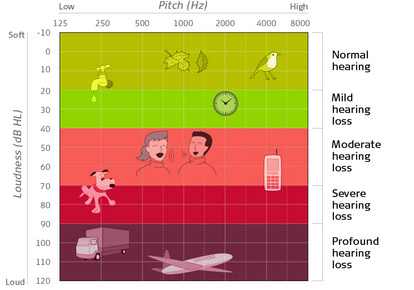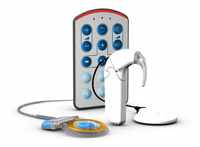Each part of the ear plays an important role in supplying the brain with sound information. Hearing loss is the result of damage to one or multiple parts of the outer, middle or inner ear. To best understand hearing loss, it may be helpful to understand the anatomy of the ear and how hearing works. The following pages will give you a general outline.
Hearing loss should always be diagnosed by a professional, such as an audiologist or an ENT specialist. The professional will test hearing in order to determine the type and severity. An audiogram, which illustrates the findings, is then prepared.
There are four types of hearing loss:
The first and most common type is
Sensorineural hearing loss which is the first and most common type it results from missing or damaged sensory cells (hair cells) in the cochlea.
Conductive hearing loss describes any problem in the outer or middle ear that prevents sound from being conducted properly to the inner ear.
Mixed hearing loss is a combined loss of both sensorineural and conductive hearing.
Neural hearing loss occurs when the auditory nerve cannot send signals to the brain.

An audiogram is a graph illustrating a person’s usable hearing and the amount of hearing loss that an individual has for each ear. Along the top of the graph, the numbers range from 125 to 8000. These numbers refer to frequencies, or different pitches of sound.
Frequency is expressed in cycles per second, or Hertz. The higher the frequency, the higher the pitch of the sound. For example, 250 Hertz (Hz) sounds like the dripping of a faucet, while the high-pitched ringing of the telephone is about 8000 Hz.
Loudness is measured in units called decibels. Zero decibels (0 dB) doesn't mean "no sound". It is just very soft. Conversational voice level is around 65 dB, and 120 dB is very, very loud – about as loud as a jet taking off when you are standing just 25 meters away. The numbers along the side of the graph are hearing levels in decibels.
During a hearing test, an audiologist presents sounds one frequency at a time. The softest tone at which a person can hear at each frequency is marked on the audiogram at that frequency and intensity. This is called the "hearing threshold".
Your audiogram is a "picture" of your hearing. It indicates how much your hearing varies from normal and, if there is a hearing loss, where the problem might be located. There are different types and degrees of hearing loss. Depending on the part of the ear that is affected, experts generally distinguish between four main types of hearing loss: conductive hearing loss, sensor neural hearing loss, mixed hearing loss and neural hearing loss.
An audiologist or hearing specialist can help you to determine if you have a hearing loss. Depending on the degree or severity, they will recommend an appropriate solution.
.
If you or someone you care about has a hearing loss, a MED‑EL hearing implant may be an appropriate solution. MED‑EL has developed three hearing implant systems designed to treat the various types or degrees of hearing loss.
A hearing loss professional will advise you concerning the optimal solution to an individual hearing loss. Below are some links to general candidacy information about hearing implants.
for individuals with severe to profound sensorineural hearing loss.
for individuals with partial deafness.
for individuals with mild to severe sensorineural hearing loss or conductive and mixed hearing losses.
for individuals with conductive and mixed hearing loss or single-sided deafness.
By electrically stimulating nerve fibres in the cochlea, cochlear implants allow recipients to perceive sound.The MAESTRO Cochlear Implant System is an effective, high performance solution for individuals with severe to profound sensorineural hearing loss. Most users can enjoy music or successfully participate in conversation, even in the most challenging listening situations.
Who Can Benefit from a Cochlear Implant System (CI)?
MED−EL cochlear implants, including the MAESTRO Cochlear Implant System, are being implanted successfully in over 90 countries worldwide by both prelingually and postlingually deafened children and adults. While it is not possible to predict exact benefits for each cochlear implant user, the following guidelines may be helpful:
A cochlear implant is designed for:
Children with a severe to profound sensorineural hearing loss in both ears. Age at implantation may be as young as several months, depending on individual circumstances and local practices

MAESTROTM Cochlear Implant System, for severe to profound sensor neural hearing loss